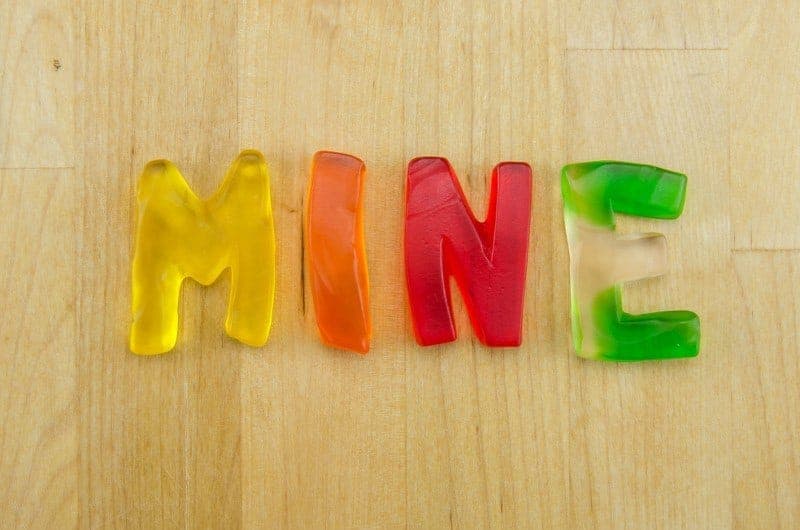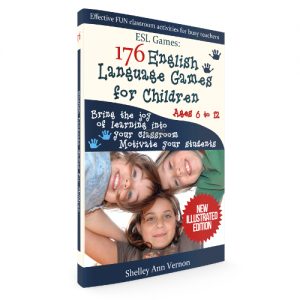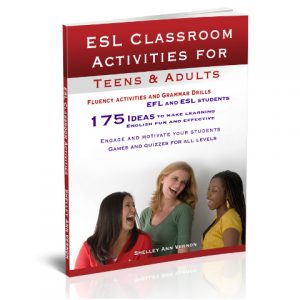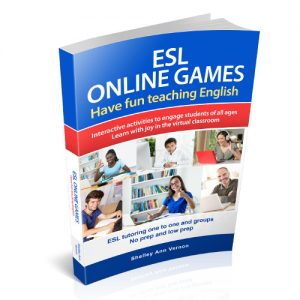Here’s a short explanation and some fun games for teaching possessive adjectives and pronouns. Unfortunately, ESL students often mix up possessive adjectives and pronouns, so let’s clear up the confusion!
Grammar
Possessive Adjectives are my, your, his, her, its, our, and their.
Possessive Pronouns are mine, yours, his, hers, its, ours, and theirs.
Explanation
A possessive adjective is not used alone. It’s my book.
Possessive pronouns can be used alone. It’s mine.
A possessive adjective describes the noun, so it comes with the noun, not alone.
It’s my book. You can’t just say « It’s my »
A possessive pronoun is used without the noun.
Whose watch is this? It’s hers.
It’s your problem, not mine.
A possessive adjective needs a noun. So, for example, in the phrase ‘your problem,’ your is a possessive adjective; it describes the noun ‘problem.’ Whereas a possessive pronoun does not need a noun. So, with ‘not mine,’ mine is a possessive pronoun and therefore is used without a noun.
Confusion teaching possessive adjectives and pronouns
Often confusion with this sort of grammar is down to the fact that students have never actually grasped either set of possessives. For example, are they able to recite the list of possessive adjectives from memory? My, your, his, her, its, our, their. If they cannot do that, there is little wonder they mix the two sets up.
Drill game for possessive adjectives
First, do some drill games on the possessive adjectives until students know them backwards. You could play Simon Says, telling students to touch things in a selection of pictures. You need a picture of yourself, a man, a woman, an animal and a group of people. Demonstrate this first using these commands:
Start with ‘touch my hair,’ and students touch your hair in the picture of you.
Next, say, ‘touch your hair’ and students touch their own hair.
Now use ‘touch her hair,’ and students touch the woman’s hair in the picture.
Then say, ‘touch his hair’ so students touch the man’s hair in the picture.
Finally, try ‘touch its tail,’ and students touch the tail on the animal picture.
For “Touch their hair,” students need to touch more than one person’s hair at the same time. However, bear in mind that many students will not want to touch others or be touched, so it’s safer to use pictures or dolls.
Repeat this but vary the things students are to touch and use Simon says: « Simon says touch his shoe. Simon says touch her bag. Simon says touch their body. Touch your hair. » Any student who touches their hair at that point loses a life.
Next, put students into groups of four to play together, with one of the students being Simon. If you don’t have enough pictures have each group quickly sketch a man, woman, baby, dog, and a group of two people using stick figures.

Drill game for possessive pronouns
Next, drill the possessive pronouns. Write the list of possessive pronouns on the board. Students pass an object around in a circle. On passing the object, the first student says, ‘it’s mine.’ The following student takes the thing and passes it on, saying, ‘it’s yours.’ The next student takes the object, passes it, and says, ‘it’s his.’
-
Games
ESL Games book for primary & middle school children
Rated 5.00 out of 5€19.97Original price was: €19.97.€15.33Current price is: €15.33. Add to cart
Continue passing and working through the list on display. Students continue non-stop passing and working down the list of pronouns. As the game goes on, erase the first pronoun ‘mine.’ Students must say that one from memory. Leave ‘It’s’ on the board as a prompt.
Next, erase “yours,” leaving “It’s” as a prompt again. Continue until you have erased all the pronouns and students know them from memory.
Here’s a fun game for teaching possessive adjectives and pronouns together. It’s called ‘Joker,’ and it’s in 176 English Language Games for Children. Instead of asking a question, students take turns to create any sentence using the two types of pronoun.
Fun game for teaching possessive adjectives and pronouns
Joker
Deal out half a pack of playing cards, including the jokers, to a small group of up to six students. The players must not look at their cards but place them face down on the table. Player 1 turns over a playing card from their pile and makes up a sentence using the two types of pronoun such as, ‘It’s my book, not yours.’ If this sentence is correct, the card is taken out of the game. If it is incorrect, the card is placed in a pile in the middle of the group.
Continue with player two, who creates a different sentence, such as ‘It’s your money, not mine.’ When the joker turns up, the person who turned it over must collect all the discarded cards from the pile in the middle, unless they have just formed a sentence correctly, in which case the joker is taken out of the game. You may like to add in a couple of extra jokers from another pack for more action!
Teaching teens and adults
If you are teaching teens or adults, you could play Typhoon along the same lines or Grammar Drill. In addition, you could play Guess the Question using questions with the two pronouns, such as ‘Is she your girlfriend or mine? Are they our pens or hers?’ (All those games are in this book of games and activities for teens and adults.)
Note: « Its » is rarely used as a possessive pronoun because « It’s its » sounds funny even though it’s correct grammatically. It’s more common to use « It’s the dog’s. »
Fun resources for teaching possessive adjectives
Get one of my great games books, and you will never be short of a fun idea again. Plus, I’m here to help if you need me.
All the best
Shelley Ann Vernon
Teaching English Games
-
Games
Games and Activities for Teens and Adults
Rated 5.00 out of 5€19.97Original price was: €19.97.€15.33Current price is: €15.33. Add to cart -
Games
ESL Games book for primary & middle school children
Rated 5.00 out of 5€19.97Original price was: €19.97.€15.33Current price is: €15.33. Add to cart
For more fun games, please check this post how to teach possessive pronouns.




6 thoughts on “Teaching possessive adjectives and pronouns”
I do believe all of the ideas you’ve presented in your post.
They’re really convincing and will certainly work.
Nonetheless, the posts are too short for starters.
May you please prolong them a bit from next time? Thank you
for the post.
Wow! Those are perfect! I will definitely use them in my lessons!
Hi,
Thank you for the post! I think it is really useful.
I bought your book 176 English Language Games for Children, but I can’t find the game Typhoon, could you explain it a little more?
Dear Almudena,
Hello there and thanks so much for your email. I’m sending you the full description via email, to your gmail address. If you have changed emails, just let me know – the best way is to email me directly on info@teachingenglishgames.com.
Look forward to hearing from you soon!
Shelley
Thank u very much for these ideas. I’ll use them in my class. But unfortunately our students in school are not motivated to learn. I think I’ll better work in language schools or on courses
Hello Leila, Thanks for your message. I’m sorry you feel defeated. Do try the ideas because if students enjoy class more, it usually motivates them. Once they see that they are learning and doing better, they can feel more inclined to stick with it. Also, remember that teachers teach more than the subject. Check this blog for ideas on that: https://teachingenglishgames.com/how-to-be-a-good-teacher/
Of course, if nothing works and if you aren’t happy then you need to change jobs, because you can’t teach well if you feel down. All the best, Shelley